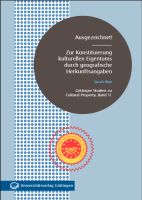Ausgezeichnet!
Zur Konstituierung kulturellen Eigentums durch geografische Herkunftsangaben
| dc.contributor.author | May, Sarah | |
| dc.date.accessioned | 2020-04-15T02:44:21Z | |
| dc.date.available | 2020-04-15T02:44:21Z | |
| dc.date.issued | 2016 | |
| dc.identifier | OCN: 1076742835 | |
| dc.identifier.uri | http://library.oapen.org/handle/20.500.12657/37146 | |
| dc.description.abstract | Article descriptions such as “Allgäuer Emmentaler,” “Dresdner Christstollen” or “Bayerisches Bier” do not simply name culinary products, but locate them in certain regions and link them to memories and associations. They prove not only a spatial (geographic), but also a temporal (traditional) embedding in a certain region of origin. Such names are self-evidently attractive to clients, who have the choice between similar products, to producers, who are involved in international competition, and not least to politicians, who are interested in the protection and promotion of the economy in their areas of responsibility. Accordingly, the European Union (EU) established a legal instrument which regulates the use of geographical indications. It is based on the assumption that regions have common climatic, geological, biological and cultural characteristics. Using the example of geographical indications and four exemplarily chosen specialties (the cheeses: Allgäuer Emmentaler, Odenwälder Frühstückskäse, Piave and Parmigiano Reggiano), Sarah May has developed an ethnographically thick, internationally comparative description of local and transnational practices in the system of EU quality schemes for agricultural products. She combines terms and theses of law and economics and translates them into an issue of cultural anthropology: She focuses on regional (culinary) culture and its economic valorization, on the interests, strategies and conflicts which accompany the transformation of regional handed-down practices and products into legally protected, spatially limited collective property. | |
| dc.language | German | |
| dc.subject.classification | thema EDItEUR::J Society and Social Sciences | en_US |
| dc.subject.other | origin | |
| dc.subject.other | indicator | |
| dc.subject.other | culinary heritage | |
| dc.subject.other | PDO | |
| dc.title | Ausgezeichnet! | |
| dc.title.alternative | Zur Konstituierung kulturellen Eigentums durch geografische Herkunftsangaben | |
| dc.type | book | |
| dc.type | book | |
| oapen.identifier.doi | 10.17875/gup2016-1005 | |
| oapen.relation.isPublishedBy | ffaff15c-73ed-45cd-8be1-56a881b51f62 | |
| oapen.collection | AG Universitätsverlage | |
| oapen.description.otherlanguage | Namen wie „Allgäuer Emmentaler“, „Dresdner Christstollen“ oder „Bayerisches Bier“ bezeichnen nicht nur kulinarische Produkte, sondern verorten diese in bestimmten Regionen, verknüpfen sie mit Erinnerungen und Assoziationen, suggerieren dadurch nicht allein räumliche, sondern auch historisch-tradierte Gebundenheit. Naheliegend, dass solche Namen einen Reiz darstellen – für die Kunden, die zwischen ähnlichen Produkten wählen, für die Hersteller, involviert in einen internationalen Wettbewerb, und nicht zuletzt für die Politik, interessiert an Schutz und Förderung der eigenen Wirtschaft. Entsprechend etablierte die Europäische Union ein Rechtsinstrument, das den Umgang mit geografischen Herkunftsangaben Bündnisweit reguliert. Es fußt auf der Annahme, dass Regionen über klimatische, geo- und biologische, doch auch kulturhistorische Charakteristika verfügen. Am Beispiel der geschützten Ursprungsbezeichnung und vier exemplarisch gewählten Spezialitäten (Allgäuer Emmentaler, Odenwälder Frühstückskäse, Piave und Parmigiano Reggiano) erarbeitet die Autorin eine ethnografisch dichte, international vergleichende Beschreibung lokaler wie transnationaler Praktiken im europäischen Geoschutzsystem. Sie verbindet Interessensfelder der Wirtschafts- und Rechtswissenschaft und macht diese zu einem kulturwissenschaftlichen Gegenstand, wenn sie das Spannungsfeld von regionaler (kulinarischer) Kultur und wirtschaftlicher Inwertsetzung beleuchtet und auf Interessen, Strategien und Konflikte fokussiert, die die Transformation von präsumiert regional tradierten Produkten in rechtlich geschütztes kollektives Eigentum begleiten. |

